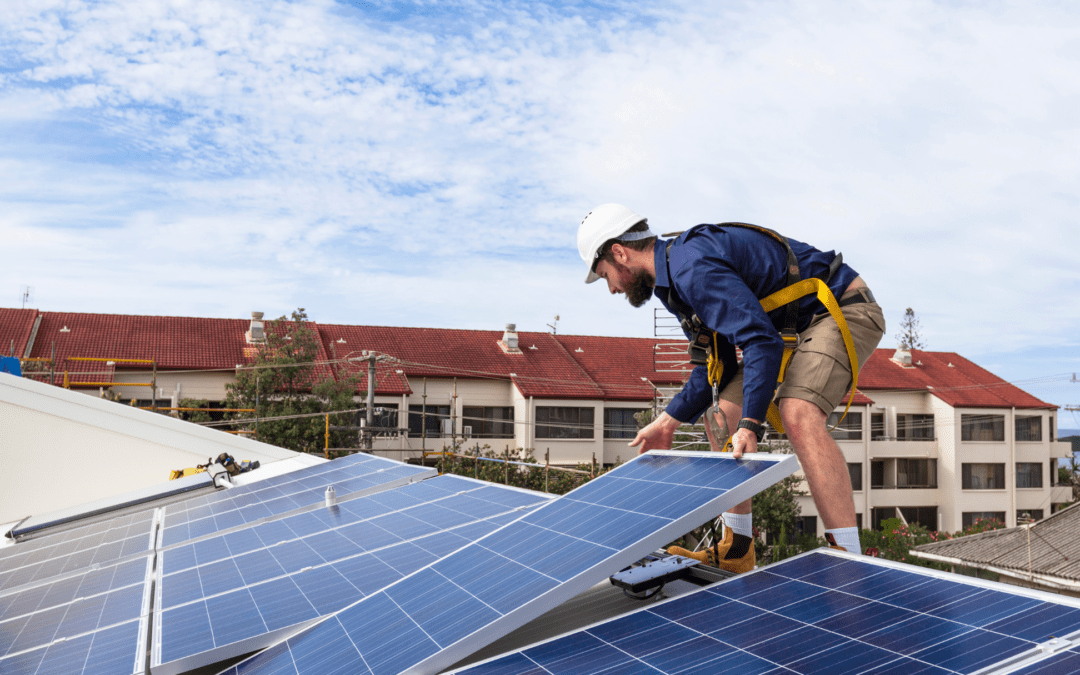When you install a solar panel array with a total rated power of 6 kW (for example, 15 x 400W PV panels), you might expect the PV panels to produce 6 kW per hour of electricity (6 kWh) during peak sunlight. However, in reality, the panels might not consistently generate their maximum rated power (the rated wattage of a solar panel indicates its electricity output when tested under ideal laboratory conditions).
In real-life installations, actual solar panel electricity output depends on external factors such as sunshine and ambient temperature, degradation, location, shading, and more. The rated wattage specified by the panel manufacturer can give you an idea of how much electricity you can expect to generate. However, unless conditions are exactly perfect, solar panels seldom generate their maximum power rating.
What are Standard Test Conditions for Solar Panels?
The standard test condition for a photovoltaic solar panel or module is defined as 1000 W/m2 (1 kW/m2) of full solar noon sunshine (irradiance) when the panel and cells are at a standard ambient temperature of 25°C with a sea level air mass (AM) of 1.5 (1 sun).
It is important to note that optimal operating temperature refers to the solar cells, not the panel itself. Therefore, the required ambient temperature for optimal operation can vary depending on the panel coatings, frame, colour, and other factors. Optimal temperature is a crucial metric as solar panels work most efficiently when temperatures range from 15°C to 35°C.
Air mass measures the amount of atmosphere that sunlight has to pass through to reach your solar panels. An air mass of 1.0 denotes that the sun is directly overhead. In laboratory tests, 1.5 is used as a more realistic estimate of real-world conditions.
Solar irradiance refers to the level of light energy shining on a given area. The 1000W/m2 rating means that tests simulate direct sunlight in the brightest part of the day without shading or clouds.
It is important to note that laboratory conditions are ideal and rarely match real-world situations.
Factors That Affect Solar Panel Output
Efficiency
Solar panel efficiency can vary from less than 10% to more than 20%. The efficiency rating refers to the amount of sunlight that can be converted into electricity when the panel is under ideal laboratory conditions. As of 2023, the most efficient solar panels available in the market range from 20.60% to 22.80%, with Trina Solar panels making the top ten list with an efficiency ranging from 18%-22.5%.
However, in actual installations, the efficiency of solar panels can be affected by various factors such as dirt and debris accumulation, high temperatures, location, and type of panel. For example, dirt, bird droppings, dust, leaves, and other debris can accumulate on the surface of your solar array, obstructing sunlight and reducing your PV panel output. You can avoid this by cleaning your solar panels once or twice a year to maintain maximum operating efficiency.
Additionally, while more sunlight generally allows solar panels to produce more power, high temperatures can have the opposite effect. Most solar panels have a temperature coefficient of around -0.3%/°C, meaning they lose approximately 0.3% of their output for every degree over 25°C. To reduce the temperature of your solar array, consider installing your panels with a gap between them and the roof. This spacing allows air to flow around the panels and cool them down.
Deterioration
Solar panels degrade with age and produce less energy. Most solar panels can maintain at least 80% of their maximum output capacity after 25 years but may reduce by around 1% annually. Physical damage from hail, wind, heavy snow, UV radiation, and thermal cycling can degrade PV panels over time. Other components such as the wiring and connections will eventually show signs of ageing, including increased resistance and efficiency loss. Inspect your PV array regularly to identify faulty components before they affect system performance.
Type of Panel
There are three main types of solar panels: monocrystalline, polycrystalline, and thin-film. Monocrystalline panels are the most efficient, with each photovoltaic cell being a single crystal of high-purity silicon. Polycrystalline panels have intermediate efficiency ratings, with their solar cells made of multiple silicon crystals. Thin-film panels are the least efficient, using a layer of photovoltaic material without crystalline structure applied on a rigid or flexible substrate. However, there are now thin-film panels with the same efficiency as polycrystalline cells.
Location
Geographical location is also a significant factor in solar panel performance as it dictates the weather, peak sun hours, and other climate conditions your PV panels will experience. For example, a solar array in the Western Cape receives more peak sun hours than in the Eastern Cape. The sun’s position in the sky constantly changes, and the ideal tilt angle to produce maximum wattage with your solar panels depends on your geographic location. Generally, in the Southern Hemisphere, your panels should face north at a ~40° tilt angle (depending on your latitude). Additionally, the air quality and altitude of your exact location can affect panel output, with smog reducing the amount of sunlight that reaches solar panels and higher altitudes resulting in a clearer atmosphere and more intense sunlight.
Inverter Efficiency
Finally, solar panels produce direct current (DC) power, but homes run on alternating current (AC) electricity. Inverters are responsible for converting DC to AC power, but some energy is lost in the process. The exact amount of energy lost depends on the efficiency rating of your inverter. To reduce power loss, an inverter with the correct capacity needs to be used in the installation. If the inverter is too small, it may not be capable of handling and converting the total power output of your solar panels. On the other hand, if the inverter is too big, it may not perform at full efficiency under light electrical loads.
Here are the key takeaways:
- Laboratory ratings rarely translate to real-world performance: Sunshine, temperature, shading, panel type, and location all play a significant role in determining actual electricity generation.
- Efficiency matters: Higher panel and inverter efficiency translates to more power harvested from the sun. Regular maintenance and cleaning are essential to maintain optimal performance.
- Location dictates sunshine: Areas with abundant sunshine hours and ideal tilt angles for the sun’s path will see higher output compared to regions with less sunlight or suboptimal placement.
- Panels degrade over time: Expect a gradual decline in power generation, but modern panels retain around 80% of their capacity after 25 years. Regular inspections can identify and address issues early on.


